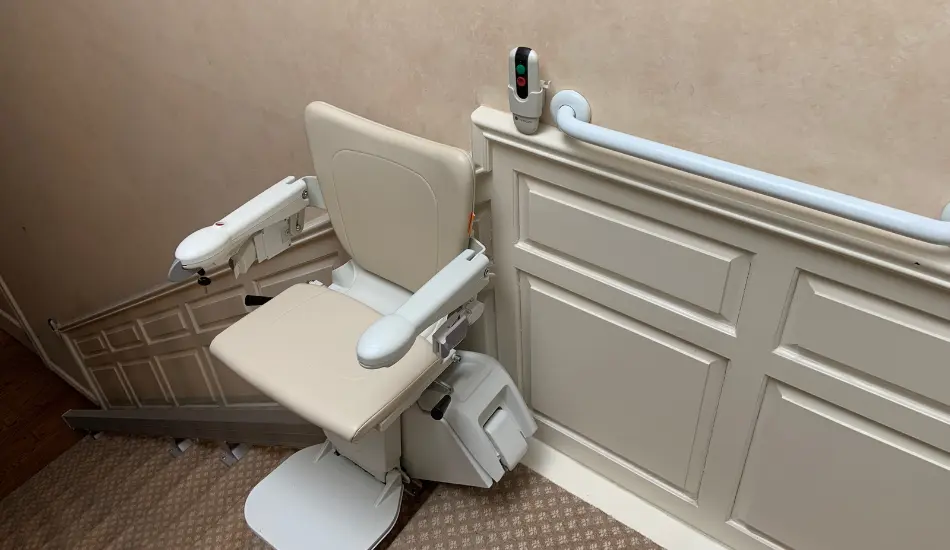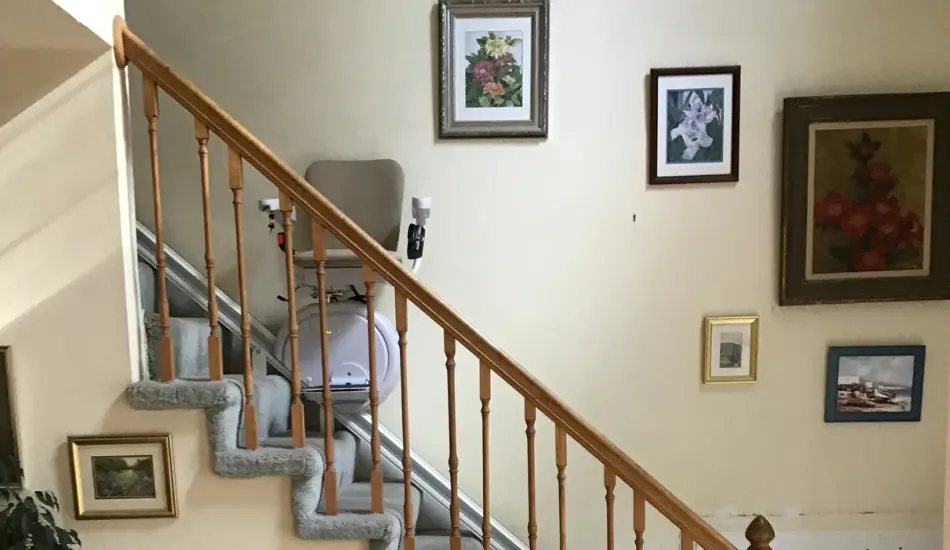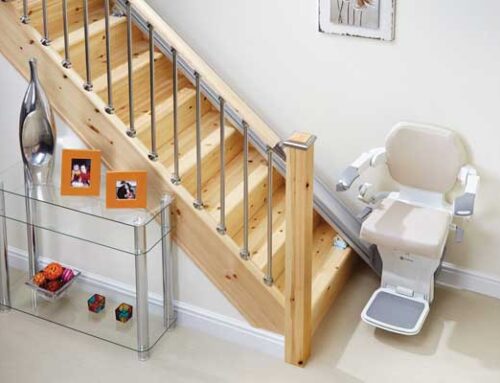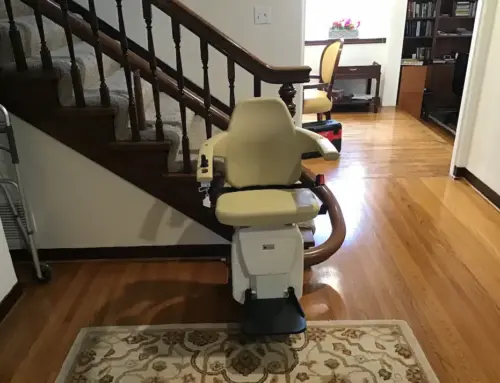Physical constraints certainly affect our standard of living. If you, your loved one, or any senior in your home face problems regarding mobility, can’t move, or can’t even stand up often, what have you considered as the solution for going up and down the stairs? Science has gifted us with a number of assistive devices, and for this particular problem, the solution is a stair lift. If you have already thought of it but are wondering how do stair lifts work, this is the right place for you!
In this article, we are offering a complete overview of these mechanized assistive tools and by the end of this discussion, you will be ready to install and use your stair-lift with confidence and peace of mind.
Understanding How Do Stair Lifts Work
A stair lift is a combination of a comfortable chair running on a carriage system and powered by an electric motor. Stairlifts are attached with wall-sided handrails. However, any stairs with open handrails on both sides are unsuitable for installing stair lifts. Let’s understand how stairlifts work first.
A comfortable, lightweight chair is installed on a rail using 2 support wheels in stairlifts. These wheels run on a chain. Just under the chair, there is an electric motor. Electric power moves the chair semi-automatically, and the user has complete control of this movement with a remote control device.
Now, let’s come to the technical part: both ends of the rails and chains are plugged into two ends of the stairs. A user can easily climb up or come down while sitting on the chair by using a remote control button.
Typically, stairlift remote controls have 2 or 3 buttons. There are buttons for climbing upstairs, coming down, and stopping in the middle. Please check the user manual before purchasing.
Sometimes, if the user has difficulties sitting on a chair, a simple platform can replace it. Users can easily stand on the platform. To reduce the height of the platform in standing stairlifts, the motor is installed in a box next to the platform. Standing stair lifts are better for elderly persons with back or knee pains as they don’t have to fold their legs.
In customized options, wheelchairs are also used as stair lift chairs. But, it is essential to check the wheelchair thoroughly before using it.
Critical Components of a Stair Lift
A simple stair lift can be customized to any required level. But here, we are discussing the core elements. A few must-have components of a stair lift are listed below.
-
Track
The stairlift track supports the chair. It is usually a geared strip that mechanically propels the chair and guides it up and down the stairway. It’s just like a train track guides a train.
-
Track Overruns
Tracks end on the edge of a stair in straight stairs. So, when the user leaves the chair, there is a minimum chance of falling. Now, if they fall on the stairs, all those initials we have taken to keep the user safe and comfortable become ineffective. That’s where track overrun supports. Track overruns mean dragging the track up to a safer position. So, even if the user accidentally falls, they won’t fall on the stairs.
-
Seat
Seats are the central functional part of a sitting stairlift. In general, stairlifts have a weight capacity of 300-400 pounds. The seats should be big enough to carry a person of this weight range. Too big chairs are not a good option as they increase the overall load on the stair lift rail; however, too small is not practical.
There are 3 types of stairlift seats,
- Swivel seats
- Armrests and footrests
- Folding seat
Collapsible or folding seats are the most common option for stair lift seats. Users can fold these seats when not in use, providing more space for non-users. A swivel seat enables you to turn the chair when you reach the top of the stairs so that you are facing away from the staircase when you get off. This makes it much easier and safer to get on and off the lift.
Another type is the perch seat, which positions the user so that they are almost standing up. Perch seats are suitable for individuals with difficulties folding their knees. Balance is also essential here. Users with low self-balance should avoid perch seats.
-
Motor
The motor is usually found within the stairlift’s base and powers the unit’s movement, so there is often no need for a separate power supply. The cost of a stair lift largely depends on the price of the motor. These motors run and stop the lift as per user instructions. A battery, also located within the stairlift’s base, powers the motor and is responsible for maintaining maximum comfort and reliability.
-
Battery
Typically, the batteries are fixed in the bottom of the chair. Battery-powered stair lifts provide lifting capability even during a power outage. In general, stairlifts are powered by two 12-volt batteries wired in series that power a 24-volt motor. These batteries range from 2.6 Ah (amp-hours) to 12 Ah. Stairlift manufacturer companies offer several battery options for operating a stairlift. You must evaluate the options carefully.
-
Safety Features
Stair lifts are particularly designed for seniors and persons with mobility issues. Understandably, the least this system requires is relentless safety. From the beginning, safety measures for these lifts have been developed gradually. Three safety features are considered must-have in a stair lift,
- Seat Belt— Seat belts keep users tightly tied to the seats of a stair lift, reducing the chances of falling or losing balance. Stairlift models with wheelchair lifts may have multiple belts to keep the user safe, steady, and properly balanced.
- Sensors—In stair lifts, sensors are installed to cut off power automatically if they detect any obstruction in their path of travel, such as anything inadvertently left on the stairs. These sensors can detect things dropped accidentally and stop ( for a set time) to let the user collect them back if necessary. These sensors can easily detect objects like handbags or walking sticks.
- Angled Seat—A straight stairlift has no angles, but some stairlift seats are slightly recumbent or backward. These angled chairs increase the safety of the user by protecting them from falling or losing balance. Typically, angled seats are used in curved stairs. Curved stair lifts are used to climb multiple stairs with 180° angles.

How to Use a Stair Chair
Using a stair chair is simple. As we have discussed, there are multiple types of stair chairs, and their uses may also differ slightly. However, the basic uses are quite similar: getting on the chair, using the lift for traveling, and getting down safely from the chair once you reach the desired floor.
-
To Get on the Stair Chair
Firstly, go closer to the chair. Unfold the chair if necessary. A stairlift chair has two safety wheel locks. Wheel locks prevent the chair from moving freely on the rail. The wheel locks can be disengaged to fasten the chair securely. Make sure locks are enabled before you sit down. Now, sit on the chair and adjust the armrests and footrests. Use seat belts for a safe ride.
-
Traveling to the Desired Floor
Once you have settled, check for any obstacles on the stairs first. Press the power button and move to the desired floor. Be calm and steady to keep your balance on the chair. Try to sit in a backward posture.
-
To Exit the Stair Chair
After reaching the desired floor, make sure you are close enough to step on the staircase platform. Now lock the wheels. Untie the seat belt and stand up or sit on another chair carefully.
Stair Lifts Are Easy to Operate
The lift travels up or down as the user pushes and holds the switch- it’s as simple! The chair will beep once and stop automatically when the stairlift reaches the end of the track. If you release the switch at any point along the way, the lift will start beeping and stop immediately. Still, you need to learn about the bottom and top landing.
-
Bottom Landing
The bottom landing is the platform on the downside edge of a stair. When using a stairlift to go downstairs, make sure you have reached the bottom landing point before standing up or exiting the lift chair.
-
Top Landing
Just like the downside edge, the upside edge of a stair has a top landing. When using a stairlift to climb upstairs, let the chair travel up to the top landing for a safe exit.
Stair Lifts Controlling
Controlling stairlift chairs in the early days was not as easy as it is today. Before purchasing, check the control features below with your dealers.
-
Remote Controls of Stair Lift Chairs
Before buying a stair lift, check for the remote control options. Remote control requires more than simply starting and stopping buttons. Check out for options associated with sensors and safety checking. In advanced products, some sensor controls never allow one to push the start button without ensuring safety.
-
Seat Controls
Seat controls are crucial, especially in a curved stairlift, with options like controls on armrest lifts. Features like customizable top rail and mid rail enhance the user experience. In some stair lift models, seats are heated. This feature is much more welcoming and comfortable for senior users, especially on cold days. Depending on the flight of stairs, the lift chair’s position can be optimized.

Stair Lifts Provide a Safe and Easy Way to Get Up and Down the Stairs
Elderly and physically challenged persons face difficulties in keeping their balance in general. Climbing up or down the house stairs adds some extra points to this difficulty. Losing balance while climbing up or coming down may cause severe accidents and make lives much more difficult. Stair lifts reduce these risks significantly. Users may sit and comfortably navigate up and down. Additionally, they reduce the physical labor. These make navigation more accessible and safer. Ultimately, stair lifts are just like mini-cars navigating the stairs.
Stair Lifts: Attach to Your Stairs, Not the Wall
Many people assume that stairlifts are attached to the wall. Actually, they attach to the stair steps. This means that a conjoining wall isn’t mandatory for installation. Stair treads are made with immense load-bearing capacity, so you don’t need to reinforce or modify them for safety.
FAQs
Q. Are Stair Lifts Noisy?
A: As we discussed above, stair lifts have a few technical parts. If the stairlift is installed perfectly, it won’t produce any noise. But you should check with the manufacturer for any unpleasant and disturbing sounds. Also, make sure that the battery is powered and charged for smooth operation.
Q. How Fast Is a Stair Lift?
A: The speed of a stair lift depends on the capacity of the motor. Professional installers set a moderate speed based on the user’s comfort. If you are finding the speed too fast or too slow, you may talk to a stair lift expert for adjustment.
Q. How Long Does a Stair Lift Last?
A: Just like any other product, longevity depends on its quality. Cheap or non-branded products may not last longer. Before purchasing one, check out the online reviews about the stairlift supplier or brand you are willing to go with. Proper installation is also important for long-lasting impact. Always look out for experienced service providers.
Q: How Wide Do Stairs Need to Be for a Stair Lift?
A: Staircases with stair lifts should have a minimum width of 28″. This size may vary depending on the lift model. In this case, try to install a stairlift that fits well on the stairs. Size also differs in straight and curved models. Proper measurement is the key to a successful installation.
Conclusion
Stair lifts are easy to use and they eliminate all limitations of using stairs. However, choosing the right stairlift for your needs depends on expertise and experience. This is where Call Before You Fall can help you with a huge collection of stair lifts and flawless installation.
Contact us today to learn more about personalized stairlift options and schedule your stairlift installation. We will happily answer any other questions you may have regarding stairlifts and associated problems.




